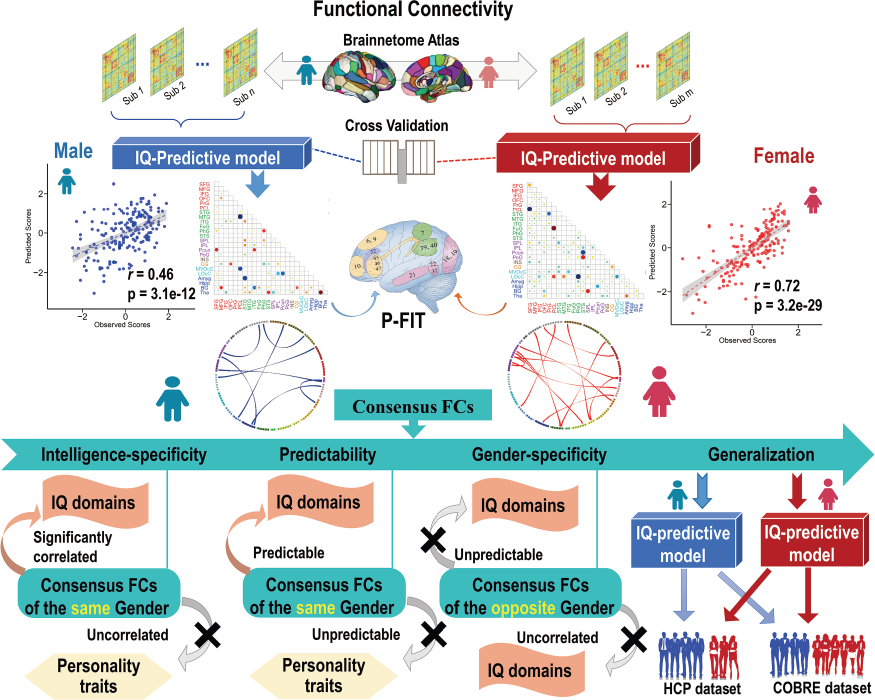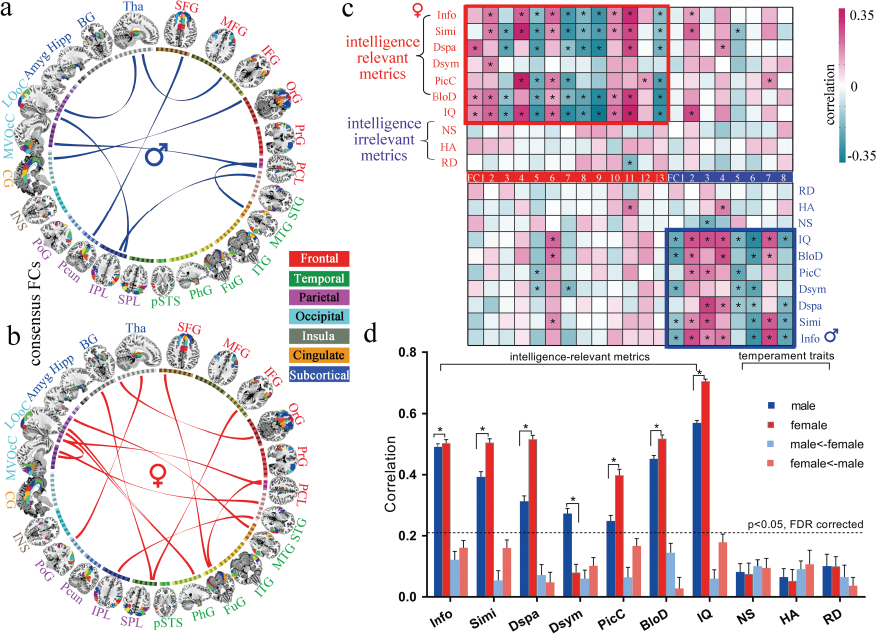Gender Differences in Connectome-based Predictions of Individualized Intelligence Quotient and Sub-domain Scores
Rongtao Jiang 1,2, Vince D. Calhoun 3, Lingzhong Fan 1, Nianming Zuo 1, Rex Jung 4, Shile Qi 3, Dongdong Lin 3, Jin Li 1, Chuanjun Zhuo 5, Ming Song 1, Zening Fu 3, Tianzi Jiang 1,2,6,7 and Jing Sui 1,2,3,7
1 Brainnetome Center and National Laboratory of Pattern Recognition, Institute of Automation, Chinese Academy of Sciences, Beijing, 100190, China
2 University of Chinese Academy of Sciences, Beijing, 100049, China
3 Tri-institutional Center for Translational Research in Neuroimaging and Data Science (TReNDS), Georgia State University, Georgia Institute of Technology, Emory University, Atlanta, GA 30303, USA
4 Department of Neurosurgery, University of New Mexico, Albuquerque, NM 87131, USA,
5 Department of Psychiatric-Neuroimaging-Genetics and Morbidity Laboratory (PNGC-Lab), Nankai University Affiliated Anding Hospital, Tianjin Mental Health Center, Tianjin, 300222, China
6 University of Electronic Science and Technology of China, Chengdu, 610054, China and
7 Chinese Academy of Sciences Center for Excellence in Brain Science, Institute of Automation, Beijing, 100190, China
Abstract
Scores on intelligence tests are strongly predictive of various important life outcomes. However, the gender discrepancy on intelligence quotient (IQ) prediction using brain imaging variables has not been studied. To this aim, we predicted individual IQ scores for males and females separately using whole-brain functional connectivity (FC). Robust predictions of intellectual capabilities were achieved across three independent data sets (680 subjects) and two intelligence measurements (IQ and f luid intelligence) using the same model within each gender. Interestingly, we found that intelligence of males and females were underpinned by different neurobiological correlates, which are consistent with their respective superiority in cognitive domains (visuospatial vs verbal ability). In addition, the identified FC patterns are uniquely predictive on IQ and its sub-domain scores only within the same gender but neither for the opposite gender nor on the IQ-irrelevant measures such as temperament traits. Moreover, females exhibit significantly higher IQ predictability than males in the discovery cohort. This findings facilitate our understanding of the biological basis of intelligence by demonstrating that intelligence is underpinned by a variety of complex neural mechanisms that engage an interacting network of regions—particularly prefrontal–parietal and basal ganglia—whereas the network pattern differs between genders.
Key words: connectome-based prediction, functional connectivity, gender difference, individualized prediction, intelligence
 | Figure 1. Flowchart of our individualized IQ prediction and validation analysis. In this study, we employed a cross-validated prediction framework to estimate individual’s IQ scores using the whole-brain FC. Gender-specific IQ-predictive FC patternswere discovered for both males and females.Moreover, the gender specificity, intelligence specificity, and generalizability of the identified FC patterns were investigated across three independent data sets and two intelligence measurements (IQ and f luid intelligence). |
 | Figure 2. Specificity and predictability of the consensus FC patterns. When summarizing the FC occurrence in all cross-validations, 8 FCs were repeatedly identified for males (a) and 13 for females (b), with a 100% identification rate, and we defined them as the consensus FCs. (c) Correlations between the consensus FCs and IQ, six intellectual sub-domains and three temperament traits scores, both in the same and the opposite gender group (significant correlations with P<0.05 were marked with .). (d) Prediction results for 10 behavior metrics (7 intelligence and 3 temperament) scores were solely based on the consensus FCs from the same or opposite gender group for male and female subjects, respectively. Here we ran multiple linear regression with 10-fold cross-validation, in which 8 male-specific or 13 female-specific consensus FCs were used as regressors to predict each of the 10 behavioral metrics. The process was performed with 100 bootstrapping repetitions with subjects randomly shuffled for each of the 10 behavior metrics. Prediction performance for females with the corresponding consensus FCs are visualized in red and males in blue, while prediction results for females with consensus FCs from the opposite gender are visualized in light red and males in light blue. |
